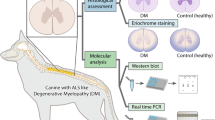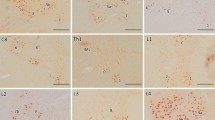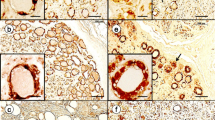Summary
-
1.
Aluminum administration to susceptible animal species results in neurofilament accumulation in neuronal perikarya and proximal axons. Pathogenetic studiesin vivo have shown that aluminum rapidly associates with neuronal chromatin. Whether the effect of aluminum on DNA components plays a role in the production of the neurofibrillary lesion remains unclear.
-
2.
In this study we used Northern analysis andin situ hybridization to evaluate mRNA levels of specific neuronal and glial components in the rabbit spinal cord at various times following aluminum administration.
-
3.
Our results show that (a) all neuronal mRNAs evaluated (neurofilament triplet components, neuronal-specific enolase, and amyloid precursor protein) are markedly decreased, with no decrease in glial fibrillary acidic protein; (b) the effect on neuronal gene expression occurs early and concurrently with the development of the neurofibrillary lesion and reverses rapidly after a single dose of aluminum; and (c) there is a direct correlation between the severity of the neurofibrillary lesion and the decrease in neuronal mRNA levels.
-
4.
We interpret our results to mean that the accumulation of neurofilaments in this model is not due to a selective effect on neurofilament gene expression but may be due to an inhibition of genes coding for components involved in processing of neurofilament proteins.
Similar content being viewed by others
References
Bizzi, A., and Gambetti, P. (1986). Phosphorylation of neurofilaments is altered in aluminium intoxication.Acta Neuropathol. (Berl.)71154–158.
Bizzi, A., Clark Crane, R., Autilio-Gambetti, L., and Gambetti, P. (1984). Aluminum effect on slow axonal transport: a novel impairment of neurofilament transport.J. Neurosci. 4722–731.
Clark, A. W., Krekoski, C. A., Parhad, I. M., Liston, D., Julien, J. P., and Hoar, D. I. (1989). Altered expression of genes for amyloid and cytoskeletal proteins in Alzheimer cortex.Ann. Neurol. (in press).
Crapper, D. R., Quittkat, S., Krishnan, S. S., Dalton, A. J., and DeBoni, U. (1980). Intranuclear aluminum content in Alzheimer's disease, dialysis encephalopathy, and experimental aluminum encephalopathy.Acta Neuropathol. 5019–24.
Crapper-McLachlan, D. R. (1986). Aluminum and Alzheimer's disease.Neurobiol. Aging 7525–532.
DuBoni, U., Seger, M., and McLachlan, D. R. (1980). Functional consequences of chromatin bound aluminum in cultured human cells.Neurotoxicology 165–82.
Feinberg, A. P., and Vogelstein, B. (1983). A technique for radiolabelling DNA restriction endonuclease fragments to high specific activity.Anal. Biochem. 1326–13.
Forss-Petter, S., Danielson, P., and Sutcliffe, J. G. (1986). Neuron-specific enolase: Complete structure of rat mRNA, multiple transcriptional start sites, and evidence suggesting posttranscriptional control.J. Neurosci. Res. 16141–156.
Hoffman, P. N., Cleveland, D. W., Griffin, J. W., Landes, P. W., Cowan, N. J., and Price, D. L. (1987). Neurofilament gene expression: A major determinant of axonal caliber.Proc. Natl. Acad. Sci. USA 843472–3476.
Julien, J. P., Meyer, D., Flavell, D., Hurst, J., and Grosveld, F. (1986). Cloning and developmental expression of the murine neurofilament gene family.Mol. Brain Res. 1243–250.
Karlik, S. J., Eichhorn, G. L., Lewis, P. N., and Crapper, D. R. (1980). Interaction of aluminum species with deoxyribonucleic acid.Biochemistry 195991–5998.
Kosik, K. S., McCluskey, A. H., Walsh, F. X., and Selkoe, D. J. (1985). Axonal transport of cytoskeletal proteins in aluminum toxicity.Neurochem. Pathol. 399–108.
Lapadula, D. M., Irwin, R. D., Suwita, E., and Abou-Donia, M. B. (1986). Cross-linking of neurofilament proteins of rat spinal cord in vivo after administration of 2,5-hexanedione.J. Neurochem. 461843–1850.
Lewis, S. A., and Cowan, N. J. (1985). Genetics, evolution, and expression of the 68,000 mol wt neurofilament protein: isolation of a cloned cDNA probe.J. Cell Biol. 100843–850.
Lewis, S. A., Balcarek, J. M., Krek, V., Shelanski, M., and Cowan, N. J. (1984). Sequence of a cDNA clone encoding mouse glial fibrillary acidic protein: Structural conservation of intermediate filaments.Proc. Natl. Acad. Sci. USA 812743–2746.
Lewis, S. A., Lee, M. G. S., and cowan, N. J. (1985). Five mouse tubulin isotypes and their regulated expression during development.J. Cell Biol. 101852–861.
Lukiw, W. J., Kruck, T. P., and McLachlan, D. R. (1987). Alterations in human linker histone-DNA binding in the presence of aluminum salts in vitro and in Alzheimer's disease.Neurotoxicology 8291–302.
Maniatis, T., Fritsch, E. F., and Sambrook, J. (1982).Molecular Cloning: A Laboratory Manual, Cold Spring Harbor Laboratory, Cold Spring Harbor, N.Y.
Matsumoto, H., and Morimura, S. (1980). Repressed template activity of chromatin of pea roots treated by aluminium.Plant & Cell Physiol. 21951–959.
Miller, c. A., and Levine, E. M. (1974) Effects of aluminum salts on cultured neuroblastoma cells.J. Neurochem. 22751–758.
Miller, F. D.,Naus, C. C., Higgins, G. A., Bloom, F. E., and Milner, R. J. (1987). Developmentally regulated rat brain mRNAs: Molecular and anatomical characterization.J. Neurosci. 782433–2444.
Minty, A. J., Caravatti, M., Robert, B., Cohen, A., Daubas, P., Weydert, A., Gros, F., and Buckingham, M. E. (1981). Mouse actin messenger RNAs.J. Biol. Chem. 2561008–1014.
Morandi, A., Gambetti, P., Arora, P. K., and Sayre, L. M. (1987). Mechanism of neurotoxic action ofβ,β′-iminodipropionitrile (IDPN): N-Hydroxylation enhances neurotoxic potency.Brain Res. 43769–76.
Muma, N. A., Troncoso, J. C., Hoffman, P. N., Koo, E. H., and Price, D. L. (1988). Aluminum neurotoxicity: Altered expression of cytoskeletal genes.Mol. Brain Res. 3115–122.
Parhad, I. M., Griffin, J. W., and Koves, J. F. (1984). Aluminum intoxication in the visual system: Morphological and axonal transport studies.Neurology 34197–198.
Parhad, I. M., Swedberg, E. A., Hoar, D. I., Krekoski, C. A., and Clark, A. W. (1988). Neurofilament gene expression followingβ,β′ iminodipropionitrile (IDPN) intoxication.Mol. Brain Res. 4293–301.
Sanderson, C., McLachlan, D. R., and DeBoni, U. (1982a). Inhibition of corticosterone binding in vitro, in rabbit hippocampus, by chromatin bound aluminum.Acta Neuropathol. (Berl.)57249–254.
Sanderson, C. L., McLachlan, D. R., and DeBoni, U. (1982b). Altered steroid induced puffing by chromatin bound aluminum in a polytene chromosome of the blackflysimulium vittatum.J. Genet. Cytol. 2427–36.
Sarkander, H. I., Balb, G., Schlosser, R., Stoltenburg, G., and Lux, R. M. (1983). Blockade of neuronal brain RNA initiation sites by aluminum: a primary molecular mechanism of aluminum-induced neurofibrillary changes?. InBrain Aging: Neuropathology and Neuropharmacology, (Aging, Vol. 21) (J. Cervos-Navarro and H. I. Sarkander, Eds.), Raven Press, New York, pp. 259–274.
Selkoe, D. J., Liem, R. K. H., Yen, S. H., and Shelanski, M. L. (1979). Biochemical and immunological characterization of neurofilaments in experimental neurofibrillary degeneration induced by aluminum.Brain Res. 163235–252.
Tandan, R., and Bradley, W. G. (1985). Amyotorphic lateral sclerosis, 2. Etiopathogenesis.Ann. Neurol. 18419–431.
Troncoso, J. C., Price, D. L., Griffin, J. W., and Parhad, I. M. (1982). Neurofibrillary axonal pathology in aluminum intoxication.Ann. Neurol. 122278–283.
Troncoso, J. C., Hoffman, P. N., Griffin, J. W., Hess-Kozlow, K. M., and Price, D. L. (1985). Aluminum intoxication: A disorder of neurofilament transport in motor neurons.Brain Res. 342172–175.
Troncoso, J. C., Sternberger, N. H., Sternberger, L. A., Hoffman, P. N., and Price, D. L. (1986). Immunocytochemical studies of neurofilament antigens in the neurofibrillary pathology induced by aluminum.Brain Res. 364295–300.
Uemura, E. (1984). Intranuclear aluminum accumulation in chronic animals with experimental neurofibrillary changes.Exp. Neurol. 8510–18.
Wen, G. Y., and Wisniewski, H. M. (1985). Histochemical localization of aluminum in the rabbit CNS.Acta Neuropathol. (Berl.)68175–184.
Author information
Authors and Affiliations
Rights and permissions
About this article
Cite this article
Parhad, I.M., Krekoski, C.A., Mathew, A. et al. Neuronal gene expression in aluminum myelopathy. Cell Mol Neurobiol 9, 123–138 (1989). https://doi.org/10.1007/BF00711449
Received:
Accepted:
Issue Date:
DOI: https://doi.org/10.1007/BF00711449




